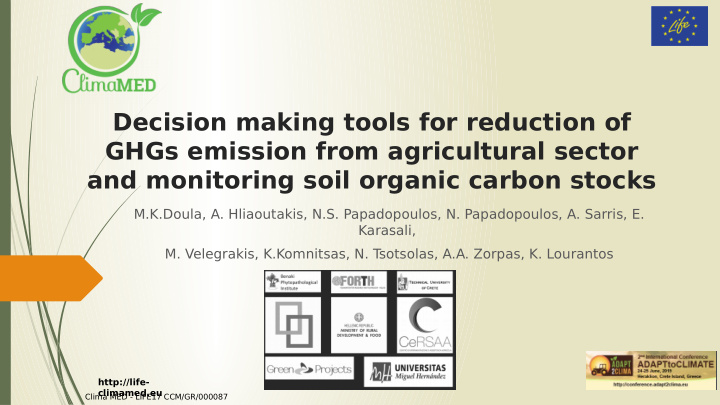



Decision making tools for reduction of GHGs emission from agricultural sector and monitoring soil organic carbon stocks M.K.Doula, A. Hliaoutakis, N.S. Papadopoulos, N. Papadopoulos, A. Sarris, E. Karasali, M. Velegrakis, K.Komnitsas, N. T sotsolas, A.A. Zorpas, K. Lourantos http://life- climamed.eu Clima MED - LIFE17 CCM/GR/000087
The establishment of data management and monitoring centers by exploiting GIS-based web apps for mapping GHGs emissions and Soil Organic Carbon (SOC) stock changes which allow the easy and visualized assessment of temporal variation of GHGs emission as well as of SOC, even at fjeld level and therefore enhance and support the role of the authorities at national and also at European level. Clima MED - LIFE17 CCM/GR/000087
Imagine something like that… Spatial data and GHG emissions at fjeld level Real time measurements of CO 2 , CH 4 . N 2 O Storing and management of data crucial for policy development (fjeld practices, energy use, natural sources use, soil quality, etc.) A platform that enables recording of envisions from agricultural sector and reporting based on a Tier3 method for GHGs and Soil Organic Carbon Stock changes Clima MED - LIFE17 CCM/GR/000087
This is LIFE ClimaMED project… “ Innovative technologies for climate change mitigation by Mediterranean agricultural sector ” Development of a GIS-based Web platform (Center of GHGs Monitoring and Management-CMM) for collecting, processing and spatially mapping GHGs and SOC data from cultivated fjelds at national level Tier3 methodology….How???? By developing an innovative methodology for GHGs measurement using LIDAR technology Clima MED - LIFE17 CCM/GR/000087
LIDAR device • The wavelength region LIDAR=Light Detection And Ranging-a selected is in the infrared technology that has been used for GHGs region (1.5-2.5 μm) appropriate for measuring quantifjcation in the past the three gases. This spectral region is selected also for some additional reasons such as eye safety, not disturbing birds and animals • Three pulsed lasers emitting at infrared wavelength region (1.6 μm for CO 2 , 1.7 μm for CH 4 and 2.3 μm for N 2 O) were merged in a device Clima MED - LIFE17 CCM/GR/000087
Clima MED - LIFE17 CCM/GR/000087
Clima MED - LIFE17 CCM/GR/000087
Clima MED - LIFE17 CCM/GR/000087
Meteorological station Autonomous photovoltaic system Clima MED - LIFE17 CCM/GR/000087
IoT device on farm equipme nt Clima MED - LIFE17 CCM/GR/000087
The pilot network consistin g of 15 fjelds in Greece Difgerent cases, e.g. organic farming, intensive cultivation, animals in fjeld, organic material spreading on soils, manure management in fjelds Clima MED - LIFE17 CCM/GR/000087
Telemetry Clima MED - LIFE17 CCM/GR/000087
Clima MED - LIFE17 CCM/GR/000087
Clima MED - LIFE17 CCM/GR/000087
The equation that provides the changes in SOC stocks is Δ SOC = NEE + CH4-C + C HARV-MAN (1) (modifjed) where -NEE is the Net Ecosystem Exchange = GPP - RE, which refmects the difgerence of CO2 amounts between Gross Primary Production (GPP = the CO2 uptake by the photosynthesis of vegetation) and Ecosystem Respiration (RE= sum of autotrophic respiration due to plant respiration and of heterotrophic one which is the sum of respiration by animals, fungi and bacteria). GPP and RE can be estimated by using meteorological data (air and soil temperature, PAR= photon fmux density of the photosynthetic active radiation and indexes as for example Normalized Difgerence Vegetation Index-(NDVI, Enhanced Vegetation Index-EVI,, Leaf Area Index -LAI, Fraction of Photosynthetically Active Radiation absorbed by plant canopies-FPAR…..) -CH4-C is the carbon removal from soil due to CH4 emissions (measured by the LIDAR devices ) -C HARV-MAN is the C difgerence between the C removal due to harvest and C addition Clima MED - LIFE17 CCM/GR/000087
Multispectral VIS/IR camera Clima MED - LIFE17 CCM/GR/000087
To be continued… Maria K. Doula Benaki Phytopathological Institute Clima MED - LIFE17 CCM/GR/000087
Recommend
More recommend